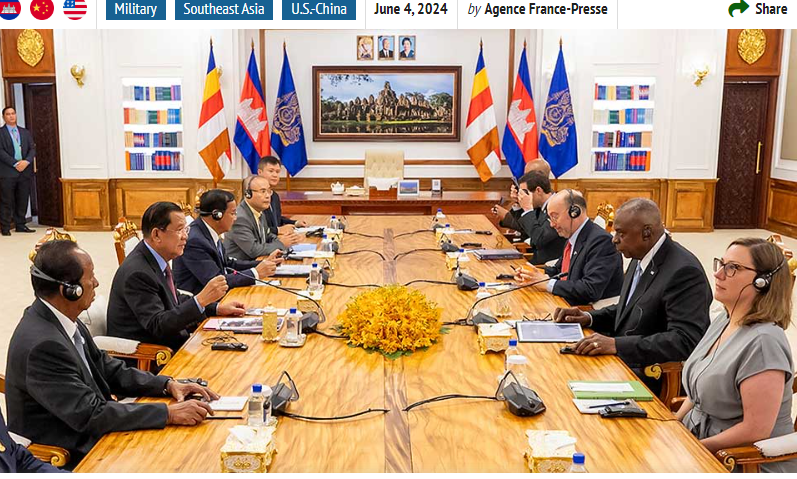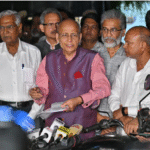Pentagon Chief in Cambodia to Bolster:-
Cambodia In a significant diplomatic move aimed at recalibrating the geopolitical dynamics of Southeast Asia, U.S. Secretary of Defense Lloyd Austin recently visited . This visit underscores the Biden administration’s strategic intent to bolster ties with a nation traditionally seen as a close ally of China. As the first Pentagon chief to visit in over a decade, Austin’s trip marks a pivotal moment in the broader U.S. strategy to strengthen alliances and partnerships in the Indo-Pacific region.
A Historical Context: Cambodia and China’s Deepening Ties
Cambodia’s relationship with China has grown remarkably close over the past two decades. Economic aid, military assistance, and infrastructural investments from Beijing have cemented this alliance. For , China represents a vital economic lifeline, contributing to the development of key projects, including roads, bridges, and the controversial Dara Sakor development project, which some analysts view as a strategic foothold for China in Southeast Asia.
This burgeoning relationship has often positioned at odds with Western nations, particularly the United States, especially in contexts where has supported China’s stances on the South China Sea disputes and human rights issues. Phnom Penh’s alignment with Beijing has been a point of contention, raising concerns about regional stability and balance of power in Southeast Asia.
The Significance of Austin’s Visit:-
Secretary Austin’s visit is a strategic effort to engage directly with Cambodian leadership and offer an alternative to China’s dominant influence. The trip is part of a broader U.S. initiative to reinforce its presence in Southeast Asia, promote a free and open Indo-Pacific, and address regional security concerns.
Austin’s agenda included high-level meetings with Prime Minister Hun Sen and Defense Minister Tea Banh. These discussions were expected to cover a range of issues, including military cooperation, regional security challenges, and avenues for deepening bilateral relations.
Upon arrival, Austin emphasized the importance of mutual respect and collaboration. “Our visit here underscores the United States’ commitment to strengthening our relationship with and supporting the broader goals of peace and stability in the Indo-Pacific region,” Austin stated.  for more information click on this link
for more information click on this link
Diplomatic and Military Engagements:-
The core of Austin’s visit focused on diplomatic engagement and exploring opportunities for military collaboration. By fostering a closer defense relationship, the U.S. aims to create a more balanced regional security framework that can counterbalance China’s growing influence.
One significant area of discussion was military training and capacity building. The U.S. has expressed interest in providing training to the Royal Cambodian Armed Forces (RCAF) in areas such as humanitarian assistance, disaster relief, and peacekeeping operations. These initiatives are designed not only to enhance military capabilities but also to build trust and foster closer military-to-military relations.
In a joint press conference, Cambodian Defense Minister Tea Banh highlighted the positive aspects of the visit. “We welcome the opportunity to enhance our defense cooperation with the United States. This visit signifies a commitment to exploring mutual interests and finding ways to work together for regional stability,” Banh remarked.
Economic and Humanitarian Cooperation:-
Beyond military collaboration, Austin’s visit also touched on economic and humanitarian cooperation. The U.S. has long been a significant contributor to humanitarian aid and development projects in . Discussions included expanding these efforts, focusing on areas such as public health, education, and infrastructure development.
The U.S. is keen to support initiatives that promote sustainable development and improve the quality of life for Cambodian citizens. By aligning development aid with the needs and aspirations of the Cambodian people, the U.S. hopes to create a more favorable perception of American engagement in the region.
During his visit, Austin toured several U.S.-funded projects and met with local communities, reaffirming the United States’ commitment to supporting development. “Our partnership goes beyond security. We are here to support the aspirations of the Cambodian people and contribute to their prosperity and well-being,” Austin stated during a visit to a community health center.
Challenges and Criticisms:-
Despite the positive rhetoric, Austin’s visit was not without its challenges and criticisms. Human rights organizations have long criticized the Cambodian government for its crackdown on political opposition, media freedom, and civil society. The U.S. has expressed concerns over these issues, and balancing these concerns with the goal of improving bilateral relations presents a diplomatic tightrope.
During his meetings, Austin raised the issue of human rights, urging the Cambodian government to uphold democratic principles and protect the rights of its citizens. “Respect for human rights and democratic values is a cornerstone of our engagement with . We encourage the Cambodian government to ensure these principles are upheld,” Austin emphasized.
Moreover, close relationship with China remains a significant barrier. Beijing’s influence in Phnom Penh is profound, and any shift towards closer ties with the U.S. may be met with resistance from within political elite, who have benefited from Chinese investment and support.
Regional Implications:-
Austin’s visit to Cambodia is part of a broader U.S. strategy to engage with Southeast Asian nations, many of which have complex and multifaceted relationships with China. By strengthening ties with countries like , the U.S. aims to promote a balance of power that prevents any single nation from dominating the region.
This strategy includes enhancing relationships with other ASEAN members and promoting multilateral cooperation through forums such as the ASEAN Regional Forum and the East Asia Summit. The goal is to create a regional environment where all nations can pursue their interests freely and peacefully, without coercion.
The Road Ahead:-
As Austin’s visit concludes, the future of U.S.-Cambodia relations remains a topic of keen interest and speculation. While the visit marks a positive step towards greater engagement, the long-term success of this initiative depends on sustained effort and mutual willingness to collaborate.
Building a robust partnership will require addressing not only strategic and security concerns but also economic, social, and political dimensions. The U.S. must continue to offer compelling alternatives to Chinese influence, demonstrating that its engagement is beneficial for Cambodia’s development and regional stability.
Voices from the Ground:-
In Cambodia, reactions to Austin’s visit are mixed. Many welcome the increased engagement and see it as an opportunity for to diversify its foreign relations and reduce overreliance on China. Business leaders, in particular, hope that closer ties with the U.S. will lead to increased investment and trade opportunities.
However, there are also voices of caution, particularly among those who view China’s support as indispensable. “China has been a reliable partner, and we must be careful not to jeopardize that relationship,” said Sokha, a local entrepreneur in Phnom Penh. “While engagement with the U.S. is beneficial, it must be balanced with our existing ties with China.”
Human rights activists are cautiously optimistic, hoping that increased U.S. engagement will bring more attention to issues of governance and civil liberties in . “We appreciate the U.S. raising concerns about human rights. It’s crucial that these issues remain a part of the dialogue,” said Sopheap, an activist based in Phnom Penh.
Conclusion:-
Secretary of Defense Lloyd Austin’s visit to represents a significant effort by the United States to bolster ties with a nation traditionally aligned with China. The trip highlights the complexities and challenges of navigating the geopolitical landscape of Southeast Asia, where strategic interests, economic dependencies, and human rights concerns intersect.
As the U.S. seeks to strengthen its presence and influence in the region, the success of this engagement will depend on sustained dialogue, mutual respect, and a clear demonstration of the benefits of a closer partnership. For , this presents an opportunity to diversify its foreign relations and pursue a more balanced approach to its international engagements.
In the broader context, Austin’s visit underscores the importance of Southeast Asia in the global strategic calculus and reaffirms the United States’ commitment to promoting peace, stability, and prosperity in the Indo-Pacific region. The road ahead is fraught with challenges, but with careful navigation and mutual cooperation, it holds the promise of a more balanced and resilient regional order. ALSO READ:- Big Wins: Ruling Parties Back in Power in Arunachal Pradesh and Sikkim 2024




